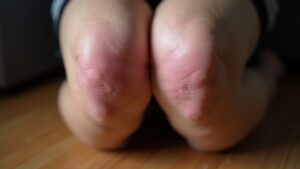Sudden bilateral knee anguish can be exasperating and alarming, especially when it strikes without forewarning. It could stem from arthritis, overuse, or even a minor misstep that strains both knees at once. Swelling, stiffness, or a feeling of instability often accompany the discomfort, making everyday movements challenging. While some cases improve with rest and ice, others might indicate a deeper issue needing medical attention. Comprehending the causes and realizing when to act can make all the difference in getting back on track.
Common Causes of Sudden Bilateral Knee Pain
Sudden bilateral knee pain can stop people in their tracks, making everyday movements like walking or climbing stairs feel impossible. Arthritis, a common cause, deteriorates the knee joint over time, leading to stiffness and discomfort.
A knee injury, such as torn cartilage or damaged ligaments in your knee, can also trigger sharp pain. Overuse or strain may inflame the joint, worsening knee problems. Even minor missteps can strain the delicate structures supporting the knee, resulting in sudden joint pain.
Identifying the causes of knee pain rapidly helps manage symptoms of knee issues before they worsen. While some cases stem from wear and tear, others arise from acute trauma. Comprehension of these triggers can guide better care and prevent long-term damage.
Symptoms Accompanying Sudden Knee Pain
Beyond the obvious discomfort, instability or frailty in the knees can make even standing feel hazardous, especially when the pain flares without warning. Sudden knee pain often comes with swelling, stiffness, or redness, making movement difficult.
A feeling of the joint giving way or buckling suggests instability, while feebleness may limit weight-bearing. Clicking or popping sounds during motion can hint at a mechanical issue, like a torn ligament or cartilage damage. Locking—where the knee gets stuck in place—may signal a loose fragment floating in the joint.
Warmth or tenderness around the knee might point to inflammation or infection. These symptoms, combined with pain, create a cycle where mobility suffers, worsening stiffness. Recognizing these accompanying signs helps identify the fundamental issue.
When to Seek Medical Attention for Knee Pain
Knee pain that appears suddenly can make even simple tasks feel challenging, especially in situations where other symptoms like swelling or stiffness make movement difficult. While some discomfort is common, severe knee pain or lingering symptoms may signal a deeper issue, such as cartilage damage or joint inflammation. People should seek medical help if pain worsens, limits mobility, or follows an injury. Red flags like fever, deformity, or inability to bear weight need immediate attention.
| Symptom | Possible Cause | Action Needed |
|---|---|---|
| Severe swelling | Joint injury or infection | See a doctor soon |
| Locking or buckling | Cartilage tear | Get evaluated |
| Fever with redness | Infection | Seek emergency care |
| Persistent pain | Chronic condition | Schedule a checkup |
Ignoring these symptoms increases the risk of long-term damage. Prompt care improves the outcome.
Immediate Relief and Home Care Options
As discomfort strikes both knees simultaneously, simple home care can help ease the pain and restore movement. Applying ice packs for 15-20 minutes reduces swelling and soothes knee pain caused by osteoarthritis or rheumatoid arthritis. Over-the-counter anti-inflammatory drugs, like ibuprofen, lessen inflammation while improving joint fluid circulation.
Wearing knee braces adds support, especially when excess weight strains the cartilage. Gentle stretches and physical therapy exercises maintain flexibility without worsening the ache. Elevating the knees above heart level minimizes fluid buildup, and resting avoids additional stress. Compression sleeves can also stabilize sore joints during daily activities.
Staying hydrated and avoiding prolonged standing eases pressure. While these steps provide relief, persistent pain might require deeper evaluation to address fundamental knee arthritis or other conditions.
Long-Term Management and Prevention Strategies
Although immediate relief helps manage sudden knee pain, long-term strategies focus on preventing future discomfort and protecting joint health. Weight loss reduces stress on the knees, easing knee arthritis progression.
Lifestyle changes, like low-impact knee exercises—such as swimming or cycling—strengthen muscles and improve joint stability. Physical therapy tailors routines to individual needs, ensuring movement without strain. Supportive footwear minimizes pressure, while knee braces or orthotics provide alignment and reduce pain. Stretching maintains flexibility, preventing stiffness.
Small, consistent adjustments—like avoiding high-impact activities—protect knee health. Strengthening exercises for the quadriceps and hamstrings add extra support. Listening to the body’s signals and adjusting activity levels prevents overuse. Together, these steps create a sustainable plan to keep knees healthy and reduce recurring knee pain.
Conclusion
Sudden bilateral knee pain can disrupt daily life, but comprehension of its causes and solutions empowers you to take control. While home care offers short-term relief, persistent or severe symptoms demand professional attention. Could prioritizing joint health today prevent bigger problems tomorrow? With the right approach—gentle movement, supportive habits, and timely medical advice—your knees can regain their strength and flexibility.


